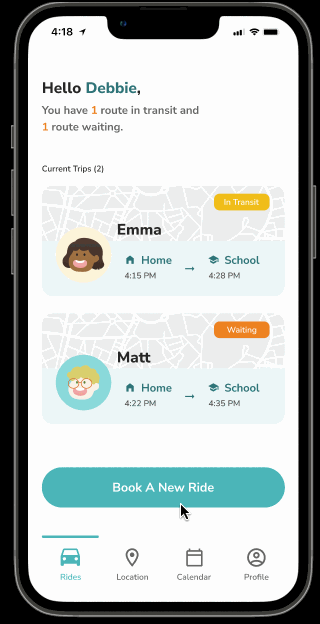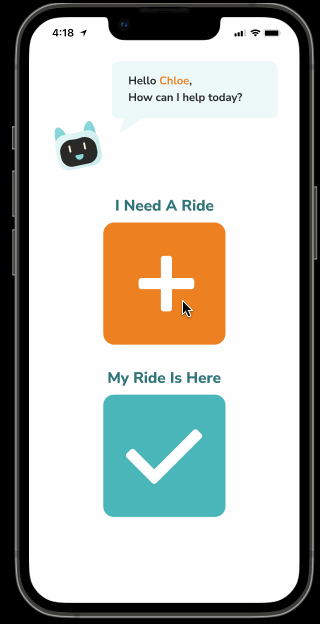
Ka-Chow ride-sharing app
KaChow - a ride-sharing mobile app connecting kids with drivers who have childcare experience so kids will have reliable access to safer rides while drivers have wider access to other income streams.
KaChow
Project Overview

Duration
Jul'22 - Sep'22
Community
IterateUX
Teammates
David Ko, Lina Lin Lee, Megan Ngai
Tools
Figma, FigJam, PowerPoint
Problem Statement
On-demand ride-sharing app has been a rapid and convenient tool for adults who need a ride to their desired destination. In response to the recent upscaling of ride-sharing apps in the market, what is the potential to introduce accessibility for children who need the same service for convenience purposes?
How can the association of ride-sharing apps for children contribute to generating passive income for under-resourced communities, such as teachers?
Solution 1 - Introduction & Brainstorming
I was randomly grouped with four teammates. In our initial meeting, we discussed our backgrounds and expertise. Subsequently, we decided to establish a FigJam board to vote on the most desired topic for our collaboration.

Solution 2 - Market Research
After the team decided to focus on assisting the underserved community, specifically teachers, we delved deeper into the topic to explore potential design solutions.
Teaching as a full-time job

Image Credit: Mother Jones (2022)
Server as a part-time job
i. Why do teachers in the United States face financial challenges?
According to Salary.com, the median salaries of various types of teachers in the United States as of September 2022 are as follows:
ii. What percentage of teachers in the United States experienced financial struggles?
In the spring of 2021, the Teacher Salary Project, a nonpartisan organization, conducted a national survey of nearly 1,200 classroom teachers.
82% of respondents said:
they either currently or previously had taken on multiple jobs to make ends meet
53% of respondents said:
they were currently working multiple jobs, including 17% who held jobs unrelated to teaching
iii. The types of side hustles held by pre-K-12 teachers
In a 2020 survey conducted by the National Education Association, 1,309 public school teachers were asked about additional jobs they worked in 2019.
47% hold another position in preK-12 education
29% hold a temporary position outside of education
19% hold permanent position outside of education
14% worked for gig economy position (eg: Uber)
iv. The percentage of teachers in the United States holding a second job
The most recent data made public by the NCES, drawing on surveys conducted in the 2017-18 school year, found that:
18% or about 600,000 public school teacher in the U.S.
held second jobs outside the school system during the school year, making teachers about three times as likely as all U.S. workers to juggle multiple jobs at once.
Based on our research, we observed a substantial demand for side hustles among teachers
So now, how can we create a kid-friendly ride-sharing service connecting experienced childcare drivers (such as teachers) to provide reliable transportation and expand income opportunities?
Solution 3 - User Research to find out how parents think about ride-sharing for their kids
We conducted two interviews with working moms in the United States, each with at least one child, to explore their experiences regarding transportation arrangements for their kids.
Christine Chen
Married with one kid (7 years old)
Full-time MBA Student; Part-time Marketing Associate
Located in Boston, MA
-
Concerns: Cares about driver’s background such as criminal record, driving record, car accident, etc.
-
Willingness: Willing to let her son start to take public transportation earliest by the age of 12 in the United States.
-
Other Findings: Will only allow her son to travel short distances independently due to safety and financial issue.
Mary Snowdall
Single mom with one kid (8 years old)
Full-time Academia Researcher
Located in Dallas, TX
-
Concerns: Cares about her son’s behavior while taking the ride. She did not want to pay for extra cleaning fees if her kid messed up the car interior.
-
Willingness: Would let her son take a private ride independently as long as the driver’s background is secure.
-
Other Findings: Used to allow her son to travel by himself from Texas to San Francisco independently.
Solution 4 - Ride-sharing Market Trend
We also researched the terms, conditions, regulations, and restrictions for the current on-demand ride-sharing products and how does it work for young families in the United States.
-
Uber and Lyft require all users to be 18 or older to hail a ride without an accompanying adult (all app users have to be 18+, but unenforced)
-
Some families still discreetly use Uber and Lyft to drive their teenage children (drivers may mistake riders’ age or intentionally don’t ask)
-
Ridesharing services catering to kids and young families are available, but often only provide pre-scheduled rides as their primary or sole offering
Solution 5 - Competitor Analysis
We also studied the competitors in the U.S. market including the product features and their target users.

Introducing a new ride-sharing app ...
KaChow (OnDemand kid-focused ride-sharing mobile app)
Design Planning 1 - Design User Personas
These user personas were crafted using online surveys, user interviews, and news coverage of families' ridesharing behaviors.

Debbie: part-time MBA student and full-time Marketing Associate
-
Debbie is currently managing a full-time job, pursuing studies, and raising three children with her spouse.
-
Despite her ambition to advance as a Marketing Manager in the next few years, she faces challenges in balancing work and life due to inflexible hours at her current job. This results in her being unable to attend her daughter Chloe's tennis class, even on weekends.
-
Debbie experiences guilt when she's late to pick up or drop off Chloe, as she strives to excel in her job and studies simultaneously.
Mom

Chloe; 6th grade student
-
Eager to join orchestra training, she faces the obstacle of no family member being available to take her to music school.
-
Although she considered taking a bus, the nearest stop is nearly 2 miles away, and her parents express concerns about her safety.
-
This situation leaves her feeling unhappy, and she often holds her working parents responsible for not having the time to support her interests and hobbies.
Child
Design Planning 2 - Determine Minimum Viable Products (MVP)
Through the analysis of affinity mapping outcomes, we gained a deeper understanding of the product roadmap and identified ways to incorporate this information into the MVP to address design challenges.

Design Planning 3 - Idea Translation from Affinity Map
Here are the key findings from the affinity mapping. These represent the essential features to include in the product.
-
Driver's Background
-
Last-min Cancellation
-
Trust Issues
-
Safety Issues
-
Ride Status Updates
Design Planning 4 - Create User Flows
Before delving into wireframes, we require user flows as a guide to organize ideas and assess whether the flow aligns with the project goals.


Design Planning 5 - Wireframes
The team discussed translating project goals into UI design, ensuring wireframes incorporate the desired impacts to address user issues.

✨ Here's how Ka-Chow solves the tension between Debbie and Chloe

Debbie booked a ride for one of her kid - Chloe
-
Debbie booked a ride for her child, Chloe, to music school, using a safety word for Chloe to verify the correct driver.
-
The live location feature allows Debbie to track Chloe's whereabouts during the trip.
-
Both should exchange contact information, and Chloe should confirm the safety word with the driver for added security.
Safety Features

Now, Chloe needs her mom's permission to book a ride home
-
Chloe, after her music lesson, uses the app to request a ride home.
-
Debbie is notified to stay informed about Chloe's location. After approval, Chloe gets details like the car plate number, driver's name, and safety word for her ride.
Eases Trust Issue
Reflections
Given additional time, I'd conduct more card-sorting exercises with diverse kids to gauge their understanding of the user interface. It's crucial for assessing potential iterations in design and content hierarchy, as well as understanding kids' readiness to take rides independently. While this would be time-consuming and resource-intensive, it's valuable for comprehensive evaluation.
.png)